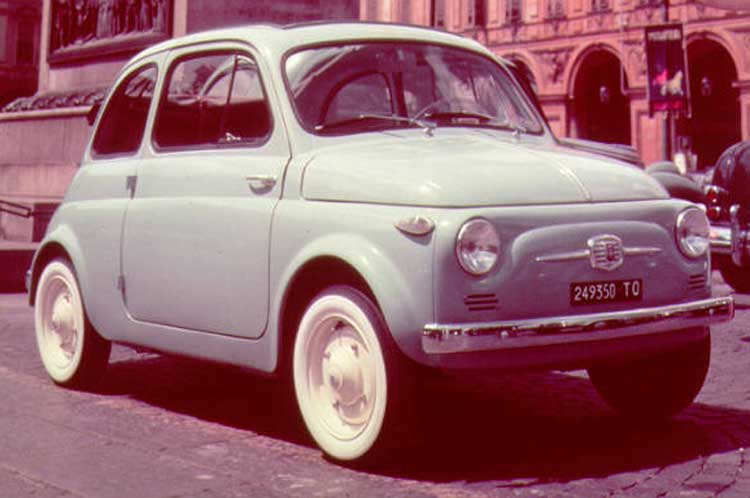Fiat 500 'Topolino'
Brian Sewell recalls a car that changed vehicle designs of the 1930s - small but perfectly formed

Your support helps us to tell the story
From reproductive rights to climate change to Big Tech, The Independent is on the ground when the story is developing. Whether it's investigating the financials of Elon Musk's pro-Trump PAC or producing our latest documentary, 'The A Word', which shines a light on the American women fighting for reproductive rights, we know how important it is to parse out the facts from the messaging.
At such a critical moment in US history, we need reporters on the ground. Your donation allows us to keep sending journalists to speak to both sides of the story.
The Independent is trusted by Americans across the entire political spectrum. And unlike many other quality news outlets, we choose not to lock Americans out of our reporting and analysis with paywalls. We believe quality journalism should be available to everyone, paid for by those who can afford it.
Your support makes all the difference.The first Fiat 500, of 1935, was just over 4ft tall, and as its seats encouraged a laid-back attitude, the viewpoint of its passengers was not much above the hubcaps of a London bus.
The first Fiat 500, of 1935, was just over 4ft tall, and as its seats encouraged a laid-back attitude, the viewpoint of its passengers was not much above the hubcaps of a London bus.
With the canvas roof rolled back and the sliding windows open, one might, windblown among the sedate Rolls-Royces of St James's, think oneself the mischievous personification of Youth at the prow and Pleasure at the helm, but to overtake the sprightly Routemaster on Piccadilly's westward run, was a terrifying adventure - a mistaken twitch of the steering wheel and one could be transformed into a work of art.
With only 13bhp under the sloping bonnet the little car's acceleration was not much better than the bus's and in urgent situations required both a heavy foot and heroic determination if it were to cleave the air displaced by the leviathan. Apart from this, it was ideal for town.
In its day the smallest car in regular production, this tiny saloon was a two-seater with squeeze room for two small children. Its body was a thing of style in which the mechanical parts (and passenger capacity) must be adjusted to fit - for the first time, styling was dominant in the design.
The result was an Art Deco toy for adults, for its time almost aeronautical in approach. Perhaps a trifle pugnacious about the nose, it is, without its headlamps, an exquisitely balanced design. It dispensed with the conventional running boards and build the body to the full width of the chassis, the curvature of its panels adding to its surprisingly generous interior. Its paint work was not the black or beige of its contemporary, the first Ford Popular, but the maroon with black wings or paired shades of grey, blue and green that were the livery of larger, more important-seeming cars
The decision to build such a small Fiat was made in 1934 when Germany was awash with micro-cars that had three wheels as often as four, two-stroke engines, two cylinders (and occasionally one), toying with air-cooling, front-wheel drive and engines at the rear.
Fiat engineers rejected these possibilities and decided on a proper car writ small; a conventional, four-cylinder engine and a chassis with big wheels and independent front suspension; the body, though entirely separate from the chassis, was to contribute to its rigidity - not quite monocoque construction, but on the way to it.
They had hoped to keep the weight down to 1,000lbs, but had to settle for just over half-a-ton; even so, it was very light - my headmaster drove one and we, half-a-dozen fifth-formers, lifted it one last day of term into the playing-field lavatories and left it there, wedged nose and tail in opposing banks of urinals.
With the driver's legs outstretched, the engine had to be installed far forward beyond the front axle where there was not a millimetre more space than for a unit of only 569cc; this offered 53mph and 53mpg; updated in1948 from side valves to overhead valves, its power increased to 16.5bhp, it could almost reach a mile-a-minute.
The gearbox was a grind with synchromesh only on 3rd and 4th. The turning-circle was so small that the Fiat 500 required little more than its own length to park.
The Topolino, the "Little Mouse" as it was affectionately but never officially known, was wonderfully stable at speed, and its agility led to amateur tinkering to increase power so no Italian road race was without its flock of these tiny machines.
In Britain, however, its cheeky chic was not deemed worth the £120 it cost when the drab Ford Pop could be had for exactly £100. What fools we were; the Ford is forgotten but the Fiat joined the immortals.
This work of genius stayed in production until 1955, its nose (alas) adjusted to post-war American proportions, and spawned station wagons called the Giardiniera and the Belvedere, as well as an ugly four-seater. Of the 519,000 made over 20 years, few survive; those that do are worth treating as significant classics.
Join our commenting forum
Join thought-provoking conversations, follow other Independent readers and see their replies
Comments